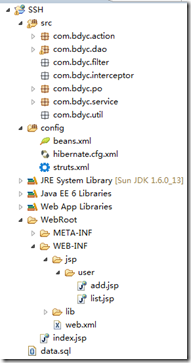SSH是Struts2、Spring和hibernate三个框架的整合,在这里就不对3个框架的原理进行详细的描述,本文章主要是为了整理一下对这3个框架的整合起来的基本配置。
现在开始我们的配置吧。
文章声明:本篇文章主要是对SSH的实现进行的一个整理,并非是一个完整的项目,在这里的所有数据都是测试数据,把握这篇文章的核心就好了。配置文件,路径都会进行图片的展示,和代码案例。
1、导包(38个)
我这里提供这38个包,点击链接:SSH必备Jar包
由于包特别的多,就在这里图片显示了。
2、再就是我们在创建我们的类的时候需要创建的几个文件个配置信息
- 在根目录下创建一个源文件夹config,和src文件夹同级别
- 在config里面创建beans.xml(spring的配置)、struts2.xml、hibernate.cfg.xml
- 在src下,我们有action、dao、service、po四个基本的包名
- jsp文件放置于WEB-INF/JSP/中
3、现在所有的准备都已经准备好了,开始写我们的配置了。
我们首先配置我们最常用的spring的配置文件beans.xml
配置文件是采用的IOC注解和aop的注解的开发。同时这里配置了hibernate的事务处理。
<?xml version="1.0" encoding="UTF-8"?> <beans xmlns="http://www.springframework.org/schema/beans" xmlns:xsi="http://www.w3.org/2001/XMLSchema-instance" xmlns:tx="http://www.springframework.org/schema/tx" xmlns:aop="http://www.springframework.org/schema/aop" xmlns:context="http://www.springframework.org/schema/context" xsi:schemaLocation="http://www.springframework.org/schema/beans http://www.springframework.org/schema/beans/spring-beans.xsd http://www.springframework.org/schema/context http://www.springframework.org/schema/context/spring-context.xsd http://www.springframework.org/schema/aop http://www.springframework.org/schema/aop/spring-aop.xsd http://www.springframework.org/schema/tx http://www.springframework.org/schema/tx/spring-tx.xsd"> <!-- 注解扫描 --> <context:component-scan base-package="com.mepapa"/> <!-- 引入式: 整合hibernate --> <bean id="sf" class="org.springframework.orm.hibernate3.LocalSessionFactoryBean"> <property name="configLocation" value="classpath:hibernate.cfg.xml"></property> </bean> <!-- 管理hibernate事务的类 TransactionManager --> <bean id="tx" class="org.springframework.orm.hibernate3.HibernateTransactionManager"> <property name="sessionFactory" ref="sf"></property> </bean> <!--通过注解管理:使用注解通过tx事务管理器管理hibernate事务 --> <tx:annotation-driven transaction-manager="tx"/> <!-- 开启@AspectJ注解支持 --> <aop:aspectj-autoproxy /> </beans>
4、这一步配置我们ORM,也就是hibernate.cfg.xml
我们在po类还有一个hibernate的配置文件,我们下面会对另一个配置文件的详细列表
<?xml version="1.0" encoding="UTF-8"?> <!DOCTYPE hibernate-configuration PUBLIC "-//Hibernate/Hibernate Configuration DTD 3.0//EN" "http://www.hibernate.org/dtd/hibernate-configuration-3.0.dtd"> <hibernate-configuration> <session-factory> <!-- 数据库 --> <property name="connection.driver_class"> com.mysql.jdbc.Driver </property> <property name="connection.url"> jdbc:mysql://localhost:3306/bdycdb </property> <property name="connection.username">root</property> <property name="connection.password">123456</property> <!-- 连接池 --> <property name="hibernate.c3p0.max_size">10</property> <property name="hibernate.c3p0.min_size">2</property> <property name="hibernate.c3p0.acquire_increment">5</property> <property name="hibernate.c3p0.timeout">600</property> <!-- Sql方言 --> <property name="dialect"> org.hibernate.dialect.MySQLDialect </property> <!-- 是否格式化 --> <property name="format_sql">true</property> <!-- 是否开启显示语句 --> <property name="show_sql">true</property> <!-- 创建表的方式 --> <property name="hbm2ddl.auto">update</property> <!-- 映射 --> <mapping resource="com/mepapa/po/User.hbm.xml" /> </session-factory> </hibernate-configuration>
这里是po类中的User.hbm.xml,对了user类这里就不累述了,自己看着写写就好了。
这里不是主要讲hibernate的用法,这里就不多进行解释了。
<?xml version="1.0" encoding="UTF-8"?> <!DOCTYPE hibernate-mapping PUBLIC "-//Hibernate/Hibernate Mapping DTD 3.0//EN" "http://www.hibernate.org/dtd/hibernate-mapping-3.0.dtd"> <hibernate-mapping package="com.mepapa.po"> <class name="User" table="t_user"> <id name="id" column="user_id"> <generator class="native"></generator> </id> <property name="username"/> <property name="password"/> <property name="birthday"/> </class> </hibernate-mapping>
5、现在进行我们struts2的配置struts.xml
在这里最重要的就是struts对象交给spring进行管理,其他和struts的配置相差无几。
<?xml version="1.0" encoding="UTF-8"?> <!DOCTYPE struts PUBLIC "-//Apache Software Foundation//DTD Struts Configuration 2.3//EN" "http://struts.apache.org/dtds/struts-2.3.dtd"> <struts> <constant name="struts.configuration.xml.reload" value="true"/> <!-- 让struts2的aciton对象交给spring管理 --> <constant name="struts.objectFactory" value="spring"></constant> <package name="user" namespace="/user" extends="struts-default"> <action name="userAction_*" class="userAction" method="{1}"> <result name="addUI">/WEB-INF/jsp/user/add.jsp</result> <result name="list" type="redirectAction"> <param name="namespace">/user</param> <param name="actionName">userAction_list.action</param> </result> <result name="listUI">/WEB-INF/jsp/user/list.jsp</result> </action> </package> </struts>
6、现在我们已经对这3个框架都进行了配置,很多新手会认为现在已经配置完毕了,可以用了。这是错的,很多人在初学的时候忘掉了很重要的配置,这是我们经常犯的错误。一定要谨记。
我们的最后一步是web.xml进行配置。
<?xml version="1.0" encoding="UTF-8"?> <web-app version="3.0" xmlns="http://java.sun.com/xml/ns/javaee" xmlns:xsi="http://www.w3.org/2001/XMLSchema-instance" xsi:schemaLocation="http://java.sun.com/xml/ns/javaee http://java.sun.com/xml/ns/javaee/web-app_3_0.xsd"> <listener> <listener-class>org.springframework.web.context.ContextLoaderListener</listener-class> </listener> <context-param> <param-name>contextConfigLocation</param-name> <param-value>classpath:beans.xml</param-value> </context-param> <filter> <filter-name>struts2</filter-name> <filter-class>org.apache.struts2.dispatcher.ng.filter.StrutsPrepareAndExecuteFilter</filter-class> </filter> <filter-mapping> <filter-name>struts2</filter-name> <url-pattern>*.action</url-pattern> </filter-mapping> <display-name></display-name> <welcome-file-list> <welcome-file>index.jsp</welcome-file> </welcome-file-list> </web-app>
7、到这里位置这就是我们的所有的SSH的配置了,在以后的使用中我们可以根据我们的使用需求进行配置,这里仅是我们使用SSH框架的一个基本配置,在以后的使用中进行调整就行了。
我们的文章就到这里了,希望大家能喜欢的我的博客。
刚刚来到这里,有不对的地方,欢迎大家指正。
























 5213
5213











 被折叠的 条评论
为什么被折叠?
被折叠的 条评论
为什么被折叠?








